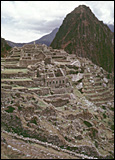
Slide of irrigation canals
Photo: Robert Lende
3000 B.C.-1000 B.C.
 unter-gatherers arrived in the Andes by at least 15,000 B.C. As the cultivation of crops developed (lima beans, potatoes, and maize being the oldest), people settled in permanent villages by 3500 B.C. Coastal settlers exchanged fish and seaweed with highlanders for such foods as potatoes. The first pottery did not appear until 2000 B.C., but Andean weavers were already crafting fine cotton textiles during the pre-Ceramic period.
unter-gatherers arrived in the Andes by at least 15,000 B.C. As the cultivation of crops developed (lima beans, potatoes, and maize being the oldest), people settled in permanent villages by 3500 B.C. Coastal settlers exchanged fish and seaweed with highlanders for such foods as potatoes. The first pottery did not appear until 2000 B.C., but Andean weavers were already crafting fine cotton textiles during the pre-Ceramic period.The invention of irrigation increased food resources and therefore populations increased. Dramatic advances in social and economic organization came about in order to direct the large amounts of labor needed to build and manage irrigation systems. Monumental ceremonial centers were built. In the highlands, agropastoralismùcomplementary farming and herdingùallowed societies to more fully exploit available resources.